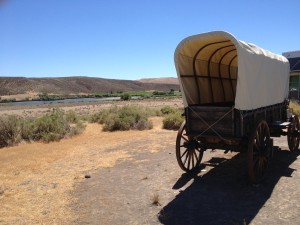As early immigrants struggled along the Oregon Trail, they had a tough decision to make as they made their way through Idaho. Should they risk the danger of crossing the Snake River or endure the dry, rocky route along the river’s south bank?
The original course of the Oregon Trail was from Independence, Missouri to Oregon City in the Willamette Valley. Although fur trappers and explorers used the travel corridor since 1811, most pioneers traveled the trail by wagon train from 1841 through 1848. By the 1860’s the trail was used very little as an emigration route.
The Oregon Trail entered Idaho in the southeast corner of the state. At Fort Hall, it joined the Snake River, following the south bank until a crossing was reached near what is now known as Glenn’s Ferry. The route left Idaho near Fort Boise after winding through 500 miles of the state.
Crossing the Snake was always dangerous, but when the water was low enough to negotiate, everyone who could took advantage of the more favorable northern route to Fort Boise. Those who crossed the river found more potable water and better feed for their stock. But during high water, most immigrants were forced to travel along the South Alternate route into Oregon, a difficult dusty trail that took its toll on man and beast.
About half of the immigrants chose to attempt the crossing by using the gravel bars that extended across the river. Not all were successful and many casualties were recorded in pioneer diaries. Many diaries also recounted how the Shoshone and Piutte Indians helped the immigrants cross the river, claiming they would have never made it without their help.
The Three Island Ford was used by pioneer travelers until 1869, when Gus Glenn constructed a ferry about two miles upstream.
Three Island Crossing State Park is located on the Snake River, just four miles off I-84, 72 miles east of Boise. As weary travelers, we drove into the park in the late afternoon on a scorching hot day. Although we didn’t have a reservation, we lucked out with a lovely, shaded campsite. We breathed a sigh of relief as we settled into our green oasis. Once rested, we enjoyed hiking the trails throughout the park. One of our hikes took us to the site where Gus Glenn’s ferry entered the water. Cables and equipment are still visible and informative signs helped us to imagine immigrants, covered wagons, stock, and freight crossing the river.
A special attraction here is the Oregon Trail History and Education Center where emphasis is placed on the Euro-Americans and Native Americans working together at the Snake River crossing. Many exhibits demonstrate the hardships of the trail. Of particular interest was a packing list for the Oregon Trail and a life-sized covered wagon. The Center also features Native American life, together with a tipi and native craft work. A small theater shows an orientation film about the Three Island Crossing.
Three Island Crossing State Park was a memorable experience with comfortable surroundings and an opportunity to learn of the area’s place in Oregon Trail history.


